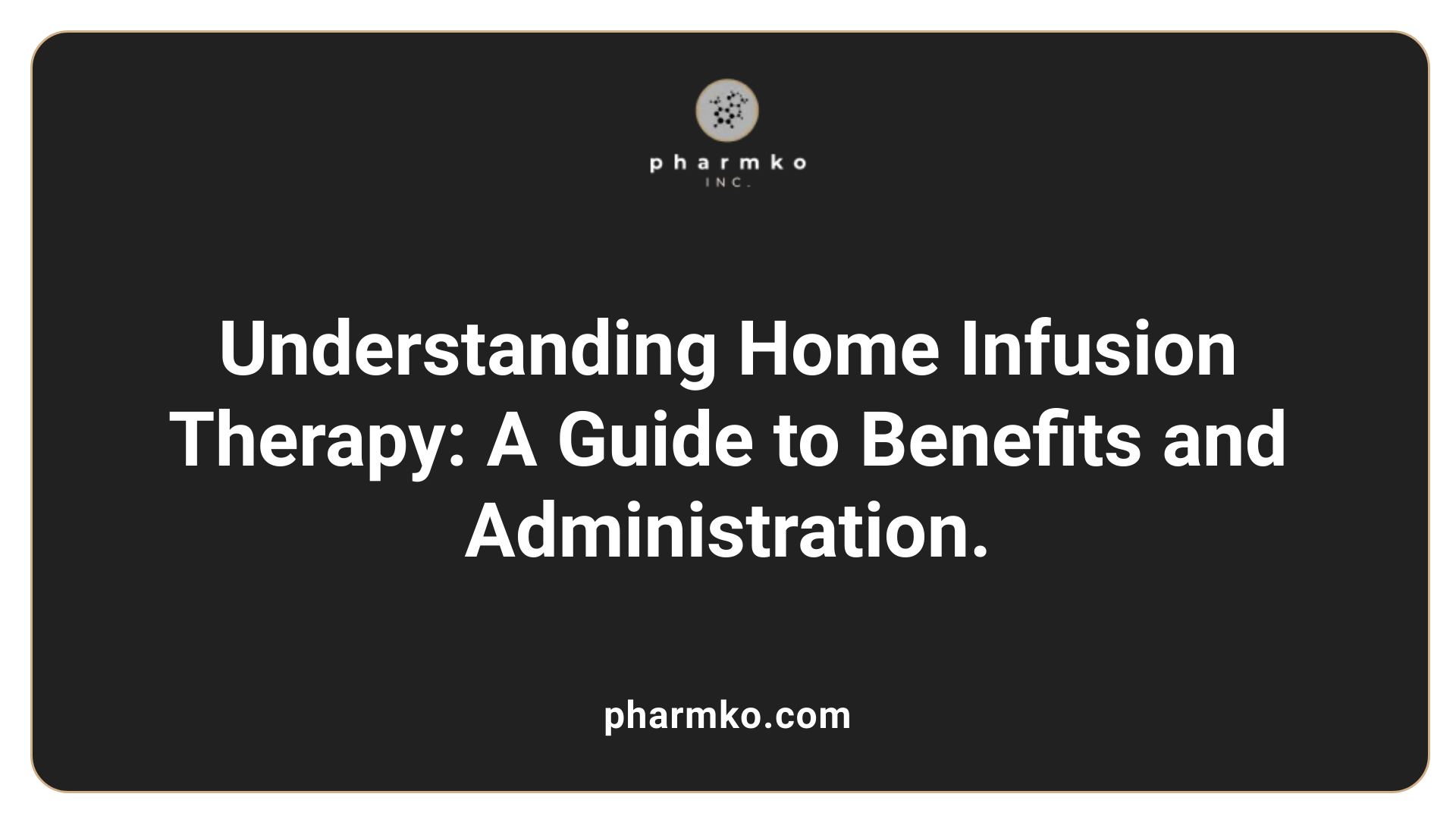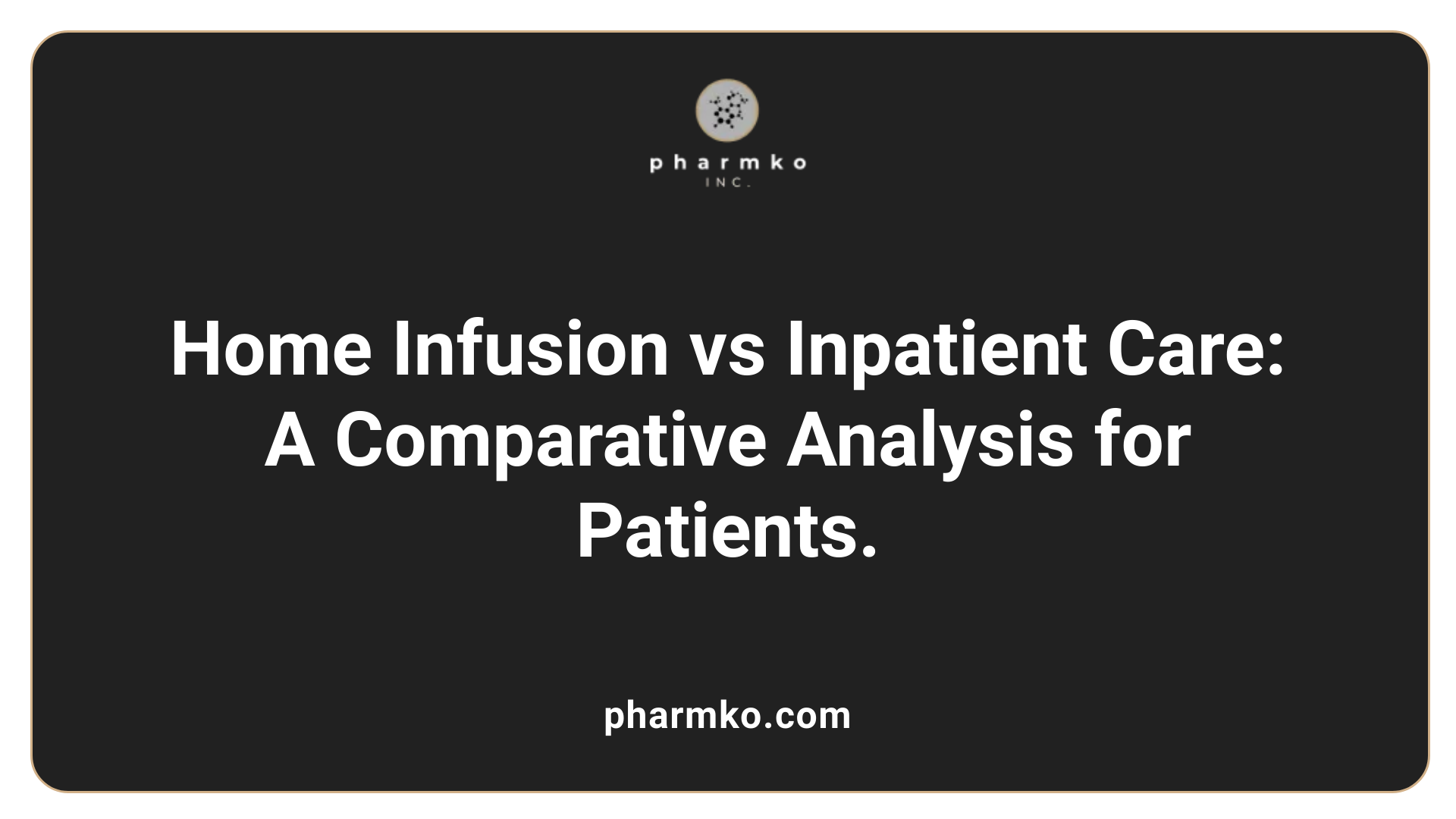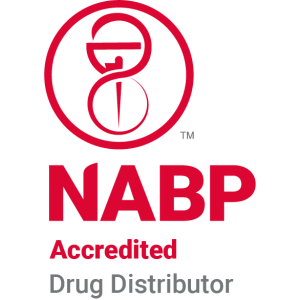Home infusion for chronic illness
Understanding Home Infusion and Its Significance
For individuals battling chronic illnesses, the prospect of frequent trips to a hospital for intravenous treatments can be daunting. Home infusion therapy offers a transformative alternative, allowing patients to receive necessary medical care in the comfort of their own homes. This therapy is increasingly recognized for its convenience, safety, and efficacy, making it an appealing option for many. Whether managing autoimmune disorders, chronic infections, or nutritional needs, home infusion therapy provides patients with the flexibility and comfort to maintain their quality of life while adhering to rigorous treatment protocols.
An Overview of Home Infusion Therapy

What is home infusion therapy and can it be done at home?
Home infusion therapy enables patients to receive medications, fluids, or nutritional support intravenously in their own homes. This therapy is designed for a variety of chronic conditions, including cancer, congestive heart failure, and gastrointestinal disorders. Patients can continue their regular activities without needing to be homebound, as treatments are tailored to their schedules. A healthcare professional usually initiates this service through a referral, and frequency of nurse visits is adjusted based on individual patient needs. Notably, many insurance plans cover home infusion therapy, so verifying coverage with one’s provider is advisable.
Which chronic illnesses can be managed with home infusion therapy?
Home infusion therapy is versatile in managing numerous chronic illnesses. Conditions include:
- Cancer-related treatments: Chemotherapy and pain management
- Autoimmune disorders: Rheumatoid arthritis and lupus
- Gastrointestinal diseases: Ulcerative colitis and Crohn's disease
- Congestive heart failure: Administration of inotropic medications
- Chronic infections: For infections unresponsive to oral antibiotics
Patients who are unable to take medications orally or require consistent treatment benefit the most from this approach, which emphasizes personalized care and safety.
Involvement of healthcare professionals
A healthcare team, including trained nurses and pharmacists, administers the infusion therapy. This professional oversight ensures proper medication handling, patient education, and monitoring of treatment efficacy. Regular communication amongst healthcare providers and patients fosters a supportive environment that enhances overall treatment outcomes.
Advantages of Home Infusion Therapy

What are the benefits and applications of home infusion therapy?
Home infusion therapy provides numerous benefits, including convenience and flexibility, as patients can receive treatment in the comfort of their own homes. This therapy allows for the management of chronic conditions through the administration of medications such as antivirals, antibiotics, and nutritional support. This involves specialized equipment and skilled nursing services for safe administration.
Safety and Efficacy
Studies show that home infusion therapy is as safe and effective as receiving treatment in a hospital setting. Patients are closely monitored by trained professionals, including nurses and pharmacists, which ensures immediate responses to any adverse reactions. The therapy helps reduce the likelihood of missed infusions and lowers the risk of infections commonly associated with hospital stays.
Impact on Quality of Life
Home infusion not only addresses medical needs but significantly improves the quality of life for patients. It allows patients, like Brekken Larson, to receive crucial treatments without the stress of traveling to a healthcare facility, fostering a supportive home environment. The continuity of care, coupled with greater patient engagement and education, contributes to better health outcomes. Overall, home infusion therapy can lead to reduced hospitalizations and financial savings for both patients and healthcare systems, making it a preferred option for many.
| Advantage | Description | Impact |
|---|---|---|
| Convenience | Treatments received at home, reducing travel stress. | Improved emotional well-being. |
| Safety and Efficacy | Monitored by healthcare professionals; lower infection risks. | Enhanced treatment outcomes. |
| Quality of Life | Better home environment supports recovery. | Increased patient comfort and independence. |
| Cost-Effectiveness | Reduces hospital stay duration and associated costs. | Financial savings for patients and systems. |
| Continuity of Care | Ongoing relationship with healthcare providers facilitates understanding. | Improved patient adherence and satisfaction. |
Cost and Insurance Considerations

What are the costs associated with home infusion therapy?
Home infusion therapy offers a financially viable alternative for patients requiring ongoing treatment. The costs typically range from $200 to over $1,000 per treatment. Since many patients require multiple treatments each month, these costs can accumulate quickly. Annual expenses can reach thousands, particularly for chronic conditions such as rheumatoid arthritis, where costs in hospital settings can soar between $36,000 and $47,000 .
Home infusion is generally significantly cheaper than traditional inpatient care. Studies suggest patients could save approximately $40,460 for anti-infective therapies alone. This cost reduction stems from the lower overhead associated with outpatient care versus hospital stays. Factors like the type of medication, frequency of administration, and individual insurance plans can greatly influence overall costs.
What about insurance coverage?
The financial landscape for home infusion therapy is further enhanced by insurance coverage. Most commercial health insurance plans reimburse home infusion as a medical service , rather than a typical prescription, which supports its cost-effective nature. Patients should confirm insurance specifics to understand their coverage and any potential out-of-pocket expenses.
Moreover, the use of biosimilars or participation in assistance programs can further help alleviate costs. Patients are often encouraged to consult with their providers about available financial aid options.
How does home infusion compare with inpatient care?
When comparing costs, home infusion typically leads to considerable savings. Treatments administered in the comfort of the patient's home tend to be more affordable than receiving similar therapies in hospitals. The convenience of home care not only fosters better health outcomes but also minimizes transportation-related expenses and the risks associated with hospital visits. Thus, home infusion therapy stands out as an effective, economically sensible choice for many patients managing chronic conditions.
Comparative Analysis: Home Infusion vs Inpatient Care

How does home infusion therapy compare to traditional inpatient treatments?
Home infusion therapy presents numerous advantages compared to standard inpatient treatments. One of the most significant benefits is the cost-effectiveness; home infusion typically averages around $122 per day, while inpatient care can reach an average of $798 per day. This financial reduction is crucial for both patients and healthcare systems.
Moreover, receiving therapy in a familiar home environment enhances comfort and often leads to better treatment adherence. Patients experience reduced stress and anxiety compared to hospital settings, contributing to a more positive overall healthcare experience.
The safety outcomes are another pivotal aspect, as home infusion is generally as safe as treatments administered in outpatient infusion centers. Infusion-related reactions and the necessity for acute care visits are comparable, reflecting similar safety standards. The proximity of healthcare providers enhances immediate response times, fostering swift action in case of any issues.
What is the role of healthcare providers in home infusion therapy?
During home infusion therapy, skilled healthcare professionals play vital roles. Registered Nurses (RNs) and pharmacists are integral in administering treatments, ensuring safe medication practices, and providing education tailored to each patient. This direct relationship cultivates trust and personalized care, which can significantly impact patient satisfaction and outcomes.
In summary, while both therapies serve critical functions in treating chronic conditions, the choice between home infusion and inpatient care largely hinges on individual patient needs, preferences, and medical conditions. The personal touch provided by home infusion can lead to improved health outcomes and overall satisfaction with the treatment process.
Getting Started with Home Infusion: Guidelines and Eligibility

What are the guidelines and eligibility criteria for home infusion therapy services?
Home infusion therapy offers a flexible solution for patients requiring long-term medical treatment at home. However, certain guidelines and eligibility criteria ensure this therapy provides safe and effective care. Patients interested in home infusion therapy must meet the following requirements:
- Medical Necessity : Patients must have a specific medical condition that requires intravenous or subcutaneous administration of medications, such as infections unresponsive to oral treatments or chronic conditions like Crohn’s disease or multiple sclerosis.
- Accredited Providers : Home infusion therapy must be supplied by accredited providers. This ensures adherence to safety and quality regulations.
- Professional Oversight : Delivery of home infusion requires the involvement of healthcare professionals, including a physician and qualified nursing staff. Patients must be under the supervision of their physician, who will prescribe a defined plan of care detailing necessary services and medications.
- Medicare Considerations : For those with Medicare, eligibility requires enrollment in Medicare Part B. Patients are generally responsible for 20% of the Medicare-approved amount, and certain medical supplies may be covered as Durable Medical Equipment (DME).
- 24/7 Support : Continuous nursing and professional support must be available, including training for home administration of medications and tele-monitoring capabilities from the infusion supplier.
Home infusion therapy provides a lifeline for many patients, enabling them to receive vital treatments while maintaining comfort and independence in their homes.
Embracing Home Infusion Therapy for Better Health Outcomes
As home infusion therapy continues to gain traction, it presents a compelling case for improving healthcare delivery for patients with chronic illnesses. By marrying advanced medical treatments with the comfort of home, this therapeutic approach not only enhances patient satisfaction but also alleviates the strain on healthcare facilities. Moreover, as healthcare insurance and provider support systems develop, home infusion therapies promise to become even more accessible, paving the way for a new era in patient-centered care that prioritizes health outcomes, cost-effectiveness, and personal well-being. For those eligible, exploring this option might not only align with personal care preferences but also represent a smart choice in managing long-term health conditions.
References
- Five things to know about home infusion - M Health Fairview
- Home infusion therapy | Home care providers | NHIA
- Home Infusion Therapy | Conditions & Treatments | UR Medicine
- Infusion Services | Johns Hopkins Care at Home
- McLaren Health Care Home Infusion Services
- Home Infusion - Memorial Healthcare System
- Home Infusion - ECU Health
- Infusion For Health: Comfortable Infusion Therapy Centers













